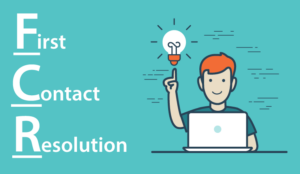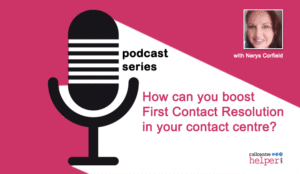Want to improve your First Time Resolution (FTR)? We asked our readers for their best tips on improving this key contact centre metric. But first, what do we mean by first time resolution?
What is First Time Resolution?
Every call centre professional understands that customers want quick access to a knowledgeable agent who can effortlessly address their concerns or questions. Therefore, resolving their issue at the first time of asking is vital for customer service in any industry. First Time Resolution (FTR) is a common phrase in call centres. It means getting things right the first time when helping customers on any channel. A perfect situation is where the service is fast and accurate.
Have a look at some of these hints and tips that have been submitted by our readers.
1. Ask the customer if the problem has been resolved
Ask the customers if they accept the resolution, and if they are happy with the agent’s service at that time.
If not, then it gives us the opportunity to take the problems further for the customer and review the call and the agent involved.
Thanks to Simon
2. Post-call customer satisfaction survey
Have a customer satisfaction questionnaire at the end of the call which can tie into a bonus or incentive. Also we need to look at using more than one method of measuring FTR. That way we know what the basic problems are and ensure the relevant training takes place across the board.
Thanks to Subreena
3. Give your staff the authority they need
Keep your staff well trained and give them extensive authority, so they won’t have to pass tasks on for policy reasons.
Thanks to Fredrik
4. Have I resolved your issue?
One of the best ways I’ve used to improve FTR is to have the agents ask ‘Have I resolved your issue today?’ or ‘Do you agree that your issue is now closed?’ as a part of the close on the call. This lets the customer say if it isn’t resolved, but also sets the idea of it being closed in their mind.
5. Conduct a contact driver analysis across teams
Conduct a contact driver analysis across teams within the business (not just the contact centre). This not only assists in FTR, but can result in preventative measures for the contact in the first place.
Thanks to Sarah
6. Cross-train agents
Cross-train agents to deal with a wide variety of issues. This has had the biggest impact on our first time resolution. We now have more agents who can help more customers, which has been key to improving our FTR by 30%.
Thanks to Adeel
7. Capture the ‘No’s
Monitor the scenarios where agents have to say no and review and improve processes or policies that drive this response. It’s a good way to find out where agents are not empowered to solve.
Thanks to Steve
8. Drive down customer effort
Measure customer effort; work to drive this down and FTR will improve.
Thanks to Kevin
9. Training is key
Ensure all agents are well trained and are fully aware of the company’s products and services as well as empowering them with the necessary tools to resolve customers’ issues.
Thanks to Kehinde
10. Follow up on dissatisfaction
Put the customer through to an IVR survey where they can answer in confidence whether their query has been resolved. Listen back to the calls that led up to dissatisfaction, contact the customer and ask the customer how you can improve.
Sent in by Debbie
11. Make key information widely available
Ensure all your information is accessible by everyone in the organisation to be able to handle the call first time.
Thanks to Martine
12. Empower your agents to deal with different personality types
Empower your agents by training them to deal with people and the dynamics of the different types of personalities you typically encounter. Most customers would rave about your service just because of the way they were treated, even if their issue was not resolved.
Thanks to Wendy
13. Let your staff do mystery shopping
Have agents do mystery shopper calls and present back their experience to peers.
14. Let agents observe each other
My tip is to have agents observing/evaluating and scoring each other, as giving poor service to a faceless customer is one thing and having it played in front of your colleagues is another… particularly if there is a communal target / bonus structure.
Thanks to Barry
15. Management must track unresolved issues
Management must track unresolved issues, then train and empower agents to resolve them. This should be done constantly and there should be an KPI attached to that cycle.
Thanks to Jennifer
16. Isolate the issue
I currently coach agents to isolate the issue and summarise before they let the customer go.
Although the customer may have other issues, it is one issue that has driven that call or email. Isolating this and resolving it will see FTR improve, but you must persist with isolating and issuing.
17. Watch out for complacency
Newer employees tend to be more vigilant and thorough in their work; the hardest thing I find is managing the old guard who get complacent.
18. Calibration sessions
We get our advisors to self-assess their calls with calibration sessions to help them realise what they need to improve. This works with both new and older advisors.
Thanks to Craig
19. Summarise
I find that summarising at the end of the call really helps, along with a set of measurable questions:
- Does the customer have confidence that the enquiry has been dealt with effectively?
- Was the agent polite and friendly?
- Will the customer need to call back?
- Ask the customer if everything has been resolved for them.
Thanks to Maxine
20. In-depth product knowledge
Our greatest tip for improving FTR is to ensure that all agents have in-depth knowledge of the products and are empowered to make their own decisions without resorting to scripted responses.
Thanks to Chris
21. Treat problems as a sales opportunity
Treat the call as a sales opportunity, monitor progress towards resolution and barge in (though chat, pop-ups) to ensure “closure”.
Thanks to Ronald
22. Look for the outliers
Meet the agents responsible for top outliers of repeat calls and ask what problems they face while handling the call.
Reduce the number of repeats and you will get higher FTR.
Thanks to Vishal
23. Compare Repeats with D-Sat
My tip: compare Repeat with D-Sat (Dissatisfaction Analysis) to know where the key challenge areas are.
Thanks to Chetan
24. The 24-hour rule
One method I have used is to ask the customer to confirm within 24 hours if their complaint has been resolved. This way the customer has enough time to test to confirm resolution. Also, leave the Ticket open for 24 hours, after which the complaint can be closed.
Thanks to Nzube
25. Don’t provide scripted responses
Provide quality, not scripted, responses to resolve the issue. This in turn makes the customer realise that they have dealt with somebody with the correct level of knowledge.
Always ask if they are satisfied with the resolution.
Training is key, and make sure the call gets routed to the correct agent thus eliminating the need to pass to somebody else.
Thanks to Charlie
26. Avoid conflicting KPIs
My tip is to avoid conflicting key performance indicators (KPIs). The biggest focus should be removing the average handle time from your business areas. This will give the advisor the time to build rapport, improve the customer journey and most likely drive down repeat calls as the customer will have had a ‘full service’ rather than an ‘interim service’.
That’s a tip given to me by a supplier when we consulted on FTR.
27. Measure more frequently
If you only measure monthly, by the time you see the Customer Satisfaction score is low, it’s going to be too late to resolve the reasons for not achieving FTR. That could be thousands of customers that could have been helped before it was published at the end of the month
28. New recruits are better at first time resolution
We have found that our newer recruits are more likely to resolve a customer issue first time than our colleagues who have been here a while.
Thanks to Cheryl
We have found that the newer recruits have had better results in this area and we use people with less tenure to coach ‘Right First Time’ messages.
Thanks to Faye
29. Give agents greater authority within set limits
Work throughout the business to improve rules that give agents greater authority within set limits. This will mean that they can resolve more customer issues without having to transfer or escalate their cases, thereby shortening call resolution time.
30. Create a knowledge base
Create a knowledge base to cover all products so all advisors are reading off the same hymn sheet. Get the customer the right information first time.
Thanks to Christopher
31. Give the directors some direction
Make first time resolution a key deliverable for the business and customer-facing directors.
Measure and publish league tables by centre by team leader.
Thanks to Steve
32. Make advisors feel part of the process of improving FTR
Listen to advisors to understand what is driving contacts. Give the advisors a feedback loop into management.
Reduce the time to feedback to the advisor from the contact event – while the event is fresh.
Thanks to Sandra
33. Empower advisors to go ‘above and beyond’
We have changed our ethos as a business to focus on giving an excellent customer experience by empowering our advisors to go ‘above and beyond’ for our customers and have removed the AHT target.
We measure advisors on achieving ‘best’ time resolution, as not everything in our industry can be resolved on the first contact.
Thanks to Jude
For more insights into First Contact Resolution, read our articles:
- 20 Tried and Tested Tips to Improve First Call Resolution (FCR)
- What Is First Contact Resolution? – With a Definition, Formula and Expert Best Practices
- How to Calculate First Contact Resolution
Author: Jo Robinson
Published On: 10th Apr 2013 - Last modified: 9th Nov 2023
Read more about - Hints and Tips, First Contact Resolution (FCR)




































All good points so Tip No34 has to be while WHAT you say is important, HOW you say it is vital.
What should be done at the end of a phone call with a customer after resolving an issue they had?
At the end of call juz sincerely say sorry for the delay and check if the customer is happy or not.Thank him/her for giving an opportunity to provide him/her the service.
set a weekly meeting with group of employees of your team to discuss the existing tools and bugs if exist and take any concerns about the system and workflows.